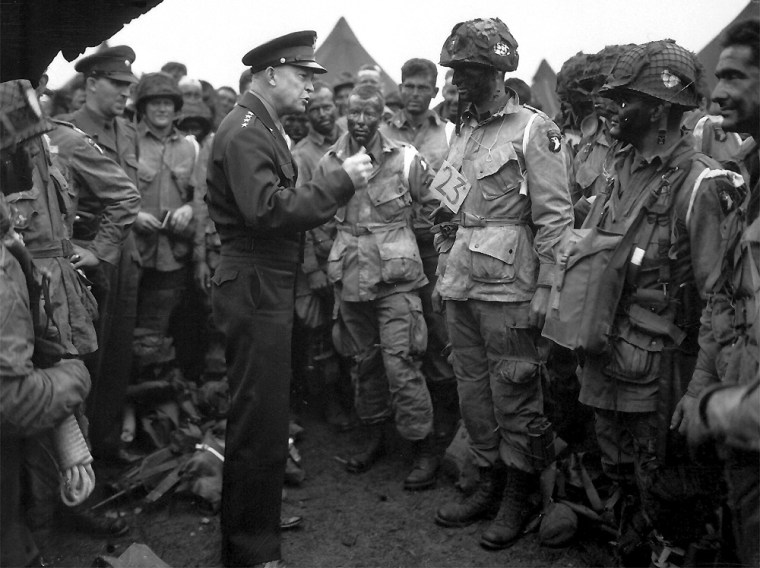When the Japanese attacked Pearl Harbor on Dec. 7, 1941, President Franklin Delano Roosevelt famously called it, "a date that will live in infamy."
The U.S. fleet in the Pacific was all but destroyed. American army units in the Philippines were the next target of the Japanese from the air and on the ground, killing thousands and taking thousands more prisoners as General Douglas MacArthur fled to the safer shores of Australia to re-group and plan his return.
The U.S. had no forces on the ground in Europe where Hitler's armies were threatening Great Britain and occupying France.
Just two years earlier the American military was ranked 16th or 18th in the world, depending on which expert you believed.
Yet, less than two years after Pearl Harbor, America was in a position to lead the greatest military invasion in the history of warfare. D-Day, June 6, 1944.
Eisenhower, took a gamble and went for it
General Dwight David Eisenhower, a career U.S. Army officer from the Great Plains who had spent most of his career as an aide to more famous generals, was in charge of a monumental force of men, ships, planes and armor from the U.S., Great Britain and Canada. He was the Supreme Allied Commander charged with first planning the invasion and then launching it.
Weather over the English Channel had already forced one delay when he was told of a brief window that would allow planes to fly as the ships and men were launched. He took the gamble and the invasion was on.
All through the night of June 5 and 6 American and British paratroopers were ferried to their drop zones to jump behind enemy lines to form a pincers movement, hoping to trap German units and keep others from counter-attacking.
Most of the young men had never been in combat before and the odds against them surviving were so great that war planners expected a casualty rate of 70 percent.
A fleet of ships, ranging from battleships to converted yachts, was steaming toward the northwest coast of France, Normandy, where the Germans were dug in but completely unaware the invasion was coming.
It is one of the most colossal intelligence failures in the history of modern warfare.
Once the C-47s carrying the paratroopers approached the coastline, the German anti-aircraft guns opened fire and the big Allied battleships off-shore began their bombardment of German positions. The Norman coast was lit up by tracer and artillery fire, bombing runs by allied planes and flares triggered to deny the invaders the cover of darkness.
On the beaches shortly after dawn, the clumsy but effective Higgins' boats, new-fangled landing craft, were unloading the invasion army 28 to 30 men at a time onto killing fields of sand and rock.
At beaches code named Sword, Juno, Gold, Utah and Omaha, German machine gunners and artillery tried to hold back the invasion force. At Omaha, they almost succeeded, costing the Allies more than two thousand casualties in the opening hours.
When the scattered paratroopers were unable to find their original destinations, they formed ad-hoc outfits and went in search of German targets.
Navy captains on destroyers off shore could see that allied bombing runs had failed to knock out German guns so they maneuvered their ships in perilously close to the shoreline and turned their big navy guns on the German positions.
Army Rangers who failed to find German artillery pieces close to the shoreline pushed inland, right into the enemy lines, to locate the guns and destroy them.
Success, a metaphor for America
The Americans and their allies succeeded, gaining a narrow foothold on French soil, just enough to establish a beachhead for the tanks, artillery, trucks, men and material that was rushed ashore for the long road ahead to Berlin.
In so many ways, D-Day was a metaphor for America: commanded by a man from a small town in America's heartland, it was a bold stroke that depended on the courage and innovation of forces still in their teens and early twenties led by senior officers in their thirties and early forties, almost all of them in combat for the first time and they were up against a battle-hardened German army that had been fighting for five years.
Yes, there were strokes of good luck that day. The German air force had been greatly diminished and it was out of position. Germany's greatest officer, Marshall Erwin Rommel, had not believed there would be an invasion so he had gone back to Berlin for his wife's birthday. The weather had cleared just enough for the invasion to take place.
Still, for all of the successes and good fortune of that day, the fighting in Europe would go one for almost another full year and it would be brutal, day in and day out. Many of the men who waded ashore at Normandy were in the thick of it for the next 12 months.
D-Day, June 6, 1944, a day that will live famously for as long as historians record the determination of free people to liberate the oppressed.
